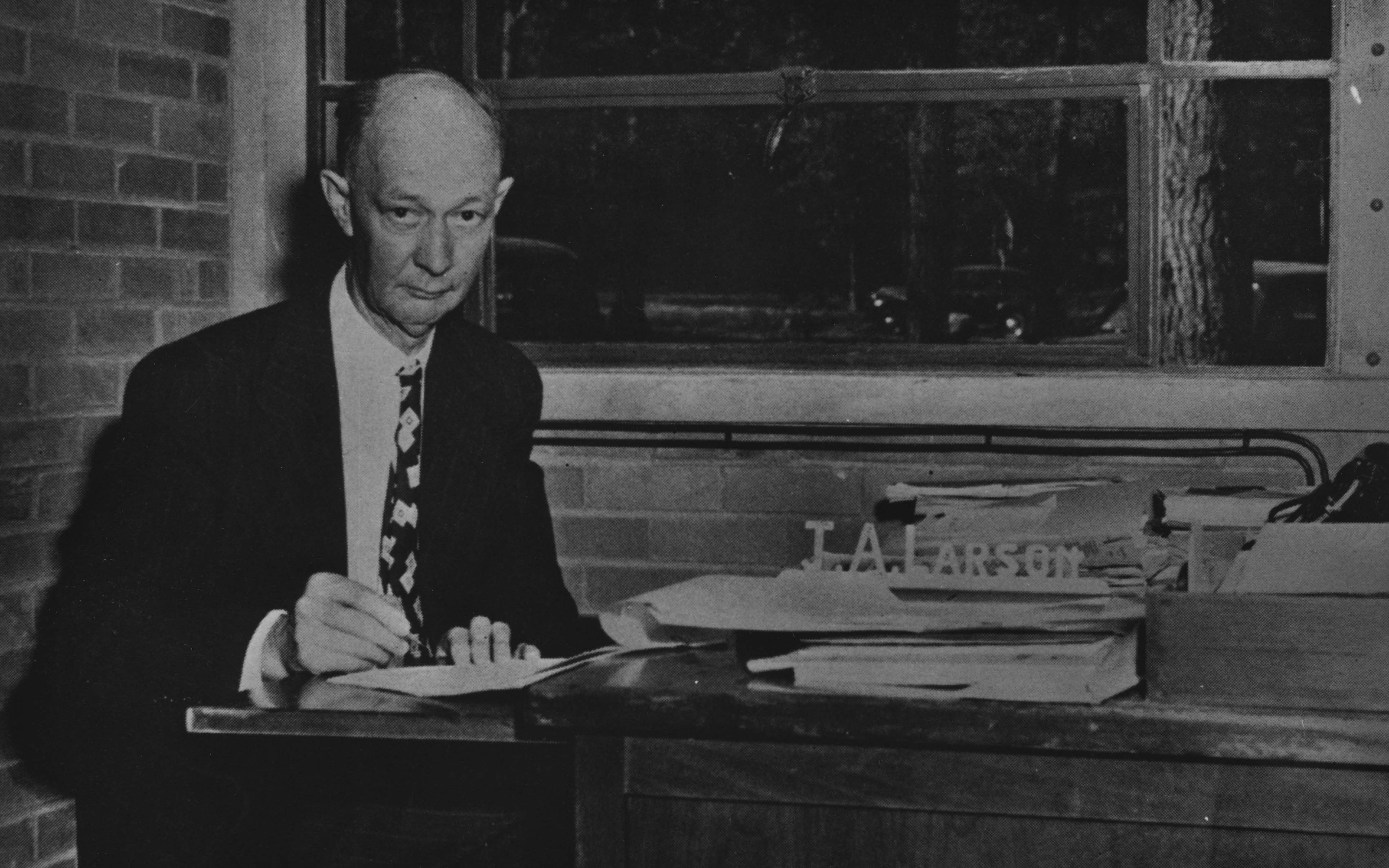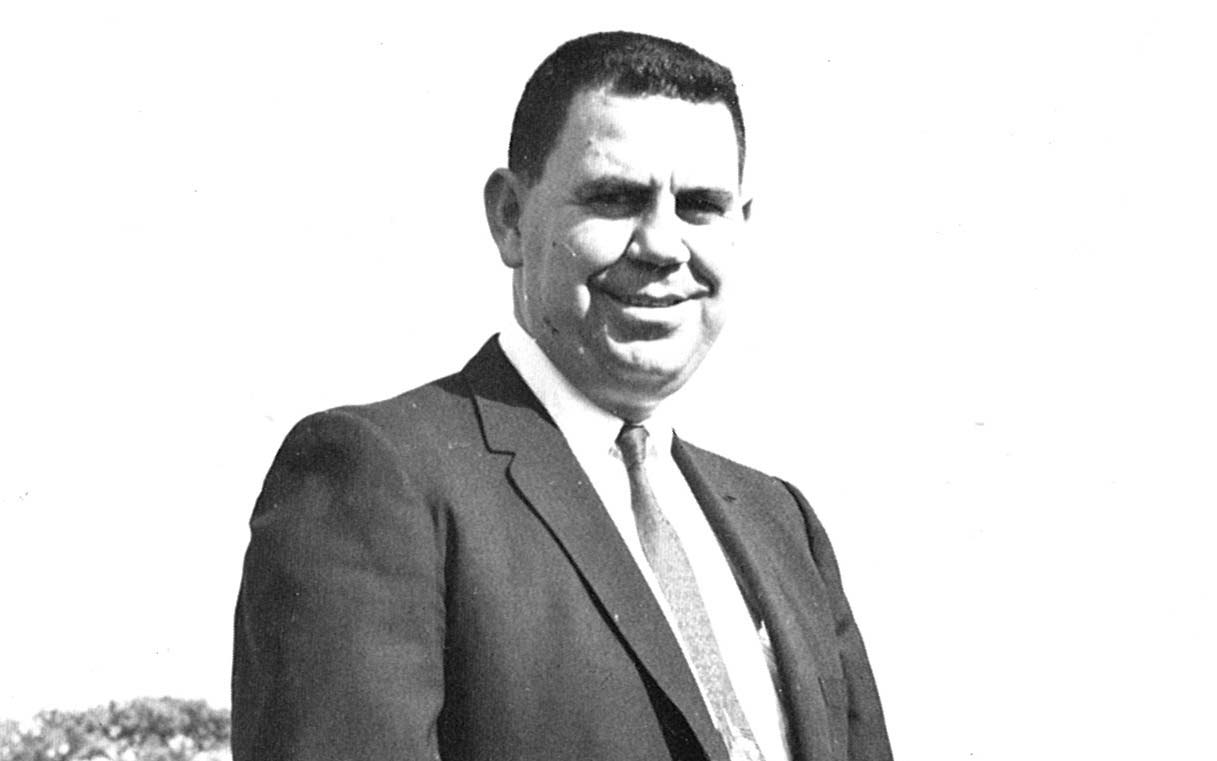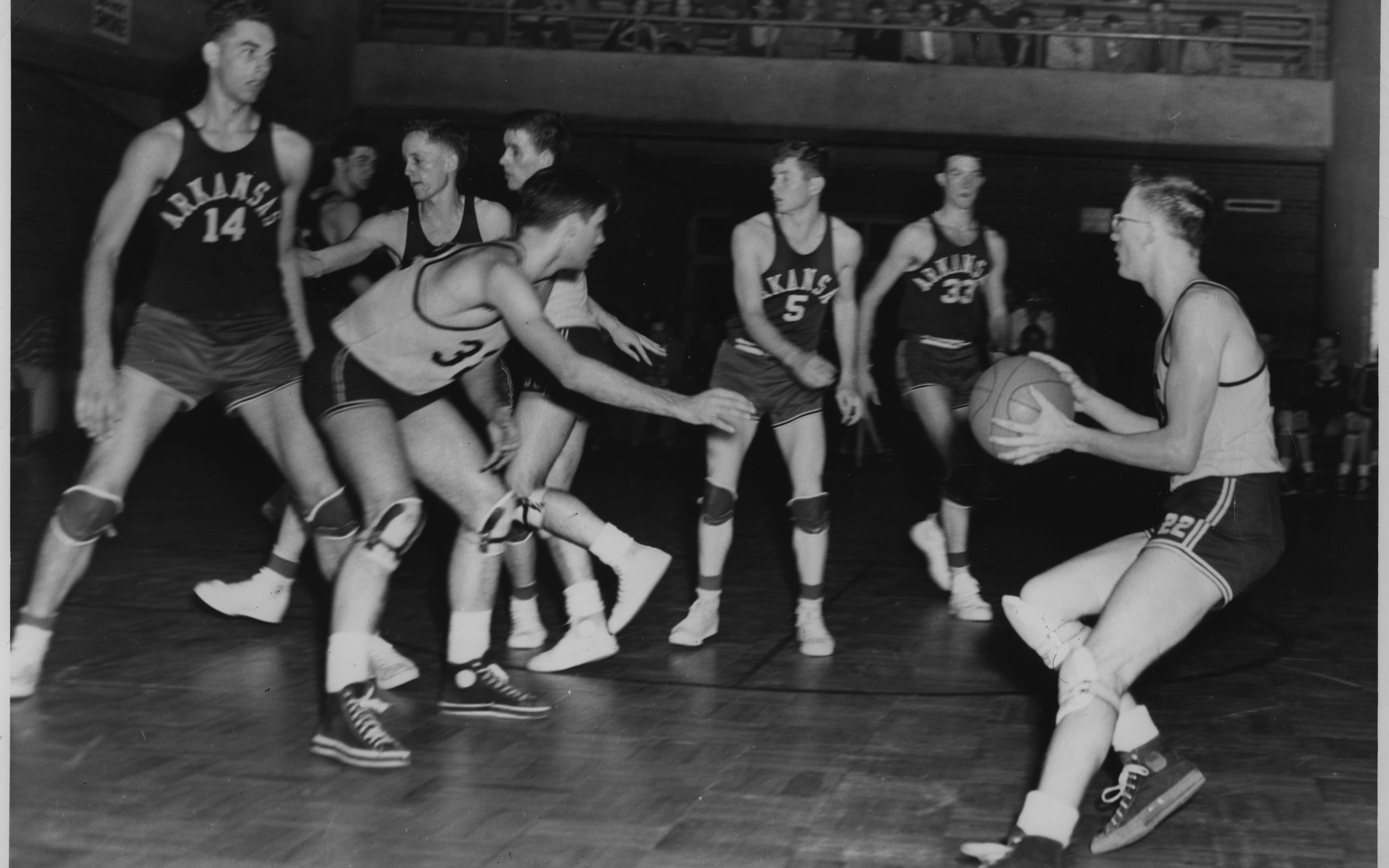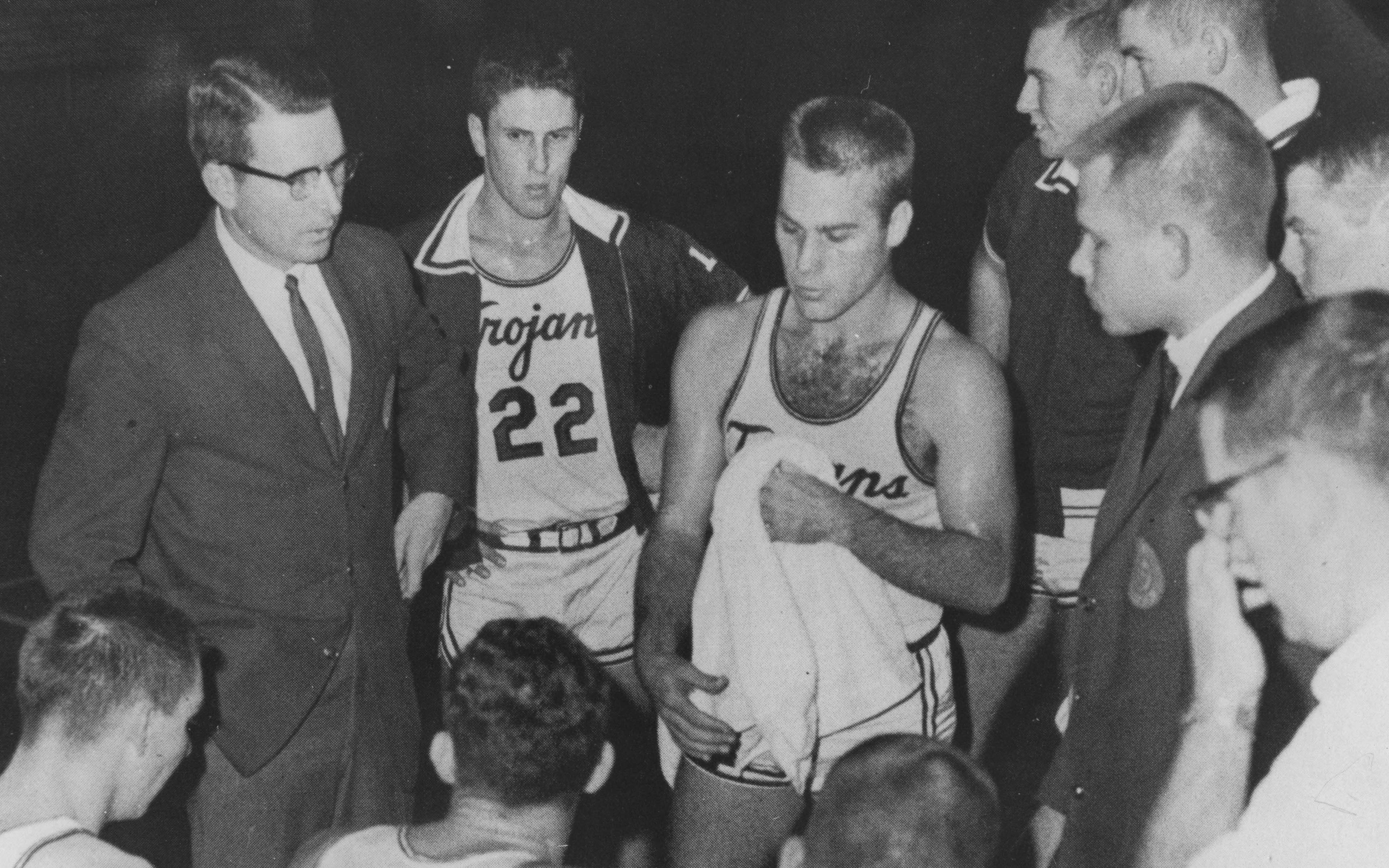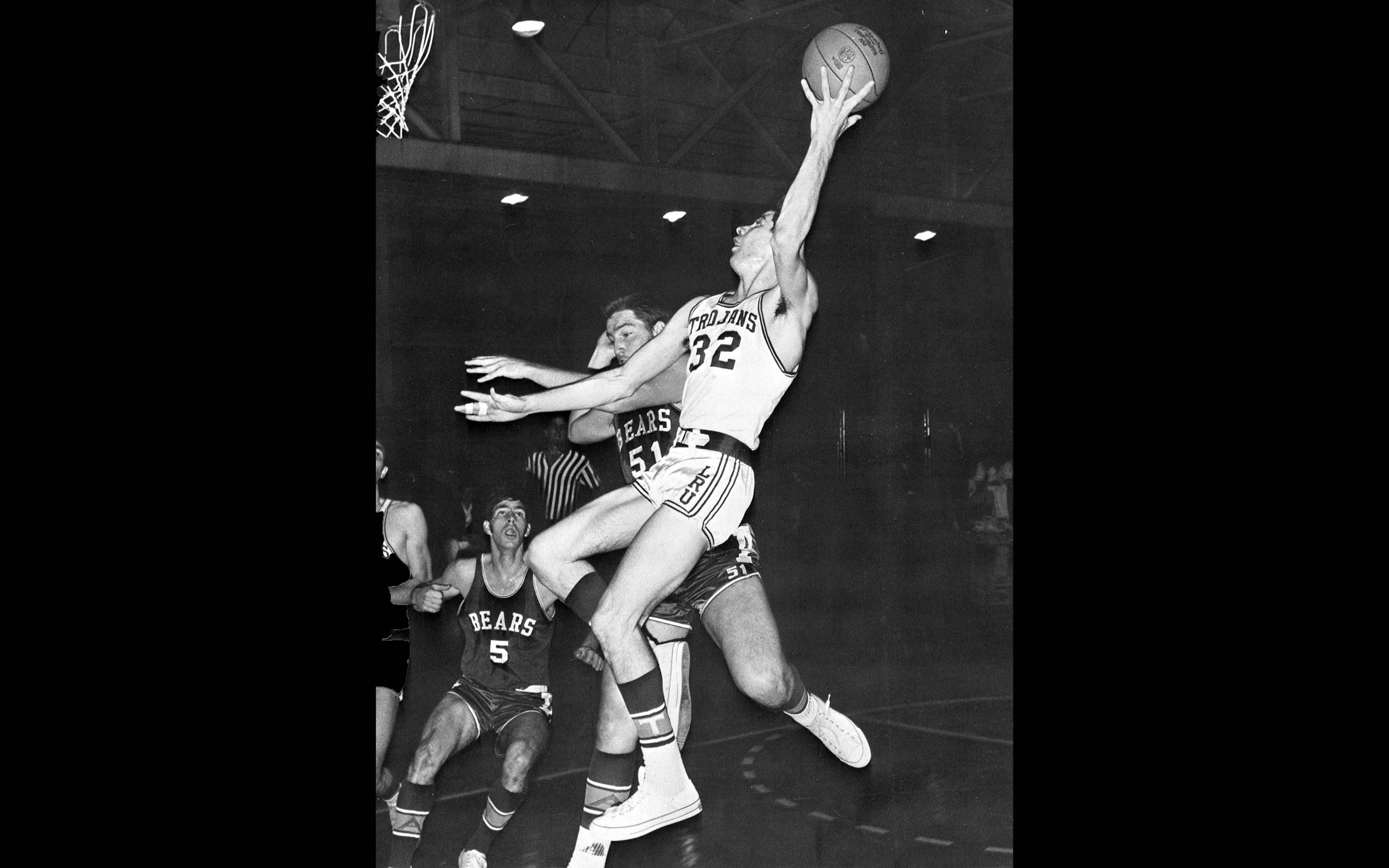Little Rock’s Team: The Early History of Trojan Basketball
December 18-24, 2017
By Kris Rutherford
When Little Rock Junior College’s (LRJC) first basketball squad, the “Jassacks,” hit the court in 1929, the two-year-old institution had few resources to support extracurricular activities. In fact, LRJC founder and President John Larson worked with such a tight budget that he took coaching duties upon himself. A varsity football and basketball player in his college years, Larson understood the important role athletics played in developing spirit and community recognition. In its first season, Larson oversaw a squad playing only half its schedule; in fact, the 1929 LRJC Jassacks are not part of official Trojan basketball history.
In 1930, Larson and his team returned, this time posting an 8-8 record against opponents like Colonial Bread and the Arkansas State Hospital before facing other small Arkansas colleges. The team managed one win in eight games against stronger competition, finishing at 9-15. After students successfully lobbied for a football team in 1931, Larson hired coaches to lead LRJC athletics and its newly adopted mascot, the Trojans, into the future.
A Decade of Failure
Alvin Lonstreth, a Faulkner County native teaching in Little Rock schools, accepted Larson’s offer to coach basketball. Both men understood legitimate college basketball programs played exclusively against college teams, not high schools or city league opponents. After beginning the 1932-1933 campaign against local church teams, by mid-season Lonstreth led the Trojan cage squad in its first step toward legitimacy. For the remainder of the decade, Trojan basketball played college opponents exclusively—schools like Arkansas State, Harding, Arkansas Tech, and Central Arkansas. The on-court results of this decision were disastrous.
During six and a half seasons of college competition beginning in early 1933, Lonstreth’s Trojans managed just 9 victories in 70 games, 4 in 1934 alone. From 1935-39, LRJC basketball posted a 2-42 record, including a 30-game losing streak when the Trojans lost by an average of 23 points. Only a two-point win in 1935 and a one-point victory in 1938 saved the Trojans from four consecutive winless seasons. Alvin Lonstreth left LRJC for medical school after 1939, and John Larson suspended the basketball program.
In the fall of 1941, basketball returned to LRJC, and an uncoahed Trojan squad managed a 6-5 record in the Little Rock City League. A year later, with World War II underway, a new coach arrived and LRJC achieved brief success against lesser competition.
The War Era
Heman L. Bogan, a native of Paragould, was lured to LRJC to teach chemistry and coach the Trojans. Beginning in 1942, he led the team to unprecedented success against a schedule made up of military opponents stationed in the Little Rock area. The Signal Corps, Army and Navy Medics, and Camp Robinson all proved rather easy competition for LRJC, and its 35-15 record over two seasons impressed. Basketball came to a halt in 1944 when military efforts shifting to end the war affected the team.
A year later, with military victory secured, the Trojans returned to the court with high hopes of success. Unfortunately, intercollegiate competition brought LRJC back to earth. Over the next 11 seasons, LRJC posted losing records under eight coaches. The longest tenured of the eight, Coach Woody Johnson posted a 25-44 record beginning in 1953 but finished a 3-17 campaign in the spring of 1956. As all LRJC athletic teams seemed in disarray, Dean E.Q. Brothers suspended athletics, citing waning student interest and scheduling difficulties. Yet, Dean Brothers left hope for the future. “I feel quite confident that if in a few years we go to a four-year school, we’ll move back to athletics.” Brothers’ confidence proved worthy.
Gaining Traction
After politicians wrangled to make LRJC a four-year university, in 1961 Coach Bill Ballard led the newly-named Little Rock University (LRU) Trojans basketball team against a higher level of competition. A two-sport, three-year letterman at the College of the Ozarks, Ballard brought athletic experience to LRU. Likewise, leadership arrived with Coach Ballard who had served as a sergeant in the Arkansas National Guard during the Korean War. His winning attitude, high expectations, and discipline would serve the LRU Trojans well for the next four seasons.
While Ballard’s 42-52 record didn’t distinguish his coaching career, he was first to lead the Trojans against out-of-state opponents like Troy State, East Texas Baptist, Nichols State, and Stephen F. Austin. Even when losing, the Trojans normally played admirably, and Ballard helped build LRU’s reputation on the court and as a university. While the Trojans managed just one winning season during his tenure (15-14 in 1963-64), Ballards assured his team would not be outclassed. LRU played hard and competed in every game, and that was enough to put spectators in the seats.
Ballard departed after the 1964-65 season. Following two years under Cleve Branscum, another College of the Ozarks athlete, LRU hired the coach who would bring its basketball program its first sense of long-term stability.
The Mahfouz Years
Happy Mahfouz brought a strong basketball background to LRU. A high school star in Louisiana, Mahfouz set over 20 team records and earned All-American Basketball honors at Spring Hill College in Alabama. Perhaps more importantly, Mahfouz was no stranger to Little Rock basketball, having spent the preceding eight years as Catholic High School’s coach.
Progress under Mahfouz was slow but steady. LRU initially played as an NAIA Independent program before moving to NCAA Division II play in the mid-1970s. After Mahfouz’s disastrous 2-21 inaugural campaign, over the next few years, victory totals increased, first to 6, then 8, 9, 16, and ultimately 18 games in 1973-1974. The season’s 18-6 record and an appearance in the NAIA District playoffs helped cement the Trojans as a veritable foe for similar schools and marked the high point of Mahfouz’s coaching career. A decline as slow and steady as the Trojans had risen ensued. In the meantime, once again, politicians worked behind the scenes on efforts that would drastically change LRU and Trojan basketball for the second time in two decades.
Stepping Up
Discussions of merging LRU with the University of Arkansas System had begun before the school even gained 4-year status in 1961. Efforts had been consistent since that time to make the affiliation reality, and in the late 1970s, legislators finally followed through. As athletic director, Happy Mahfouz realized the change was imminent, and in his last few years as coach increased the number of Division I opponents on the Trojans schedule. While some claimed UA Little Rock not ready for Division I, Mahfouz cited the NCAA’s tightening standards which would make UA Little Rock’s Division I approval more difficult in future years. Mahfouz made no efforts to gloss over the magnitude of the decision for the UA Little Rock athletics program.
The campus newspaper, the Forum, quoted Mahfouz as saying, “We may have to take our licks for a year or so, but it’s a big step for our program.” He also noted that immediately after the announcement was made, recruits showed increased interest in visiting the Trojan basketball program. “Financially, we should be able to get money guarantees from our opponents,” he added. Our gate receipts should be higher, and we should be able to sell season tickets. The academic requirements will be higher which will give us a better caliber of athletes …”
In 1978, the program that in 1930 played high schools and city league teams finally arrived. After one unsuccessful (6-20) season as a Division I Independent school, the Trojans joined the Trans America Athletic Conference. Malfouz stepped aside to become full-time athletic director, a decision paying quick dividends on the basketball court.
When Happy Mahfouz hired Centenary assistant Ken Kestenbaum to lead the Trojans, he also hired the first non-native Arkansan to coach Little Rock’s team since John Larson in 1930. Hailing from New York City’s Bronx borough, Kestenbaum’s connections in the Northeast transformed the UA Little Rock roster. In 1978, five Arkansans and one New Yorker played for UA Little Rock. A year later, the roster included just one Arkansan and seven New Yorkers. In Kestenbaum’s second season, ten players from New York/New Jersey made up the bulk of the Trojan squad.
Coach Kestenbaum’s impact was immediate and dramatic. He took the leftovers of Malfouz’s 1978-1979 team and turned in a 16-10 record his first season and 13-13 in his second. But in 1981, the Trojans gelled, winning 19 games, the most since LRJC’s 22 wins in 1944. A year later, Kestenbaum’s Trojans posted a 23-6 mark, including a 12-2 conference record. Only a heartbreaking 68-67 loss to Georgia Southern in the TAAC tournament kept UA Little Rock from grabbing its first conference title and a berth in the NCAA tournament, a phenomenal feat for a program only 5 years into Division I status.
When his fifth season ended a disappointing 14-15, Kestenbaum returned to New York. But the excitement he created in the basketball program remained. Students and the community alike realized UA Little Rock could support a winning team. It only needed a coach ready to take the program to the next level. That coach would arrive in the fall of 1984 as UA Little Rock Basketball made the move from Division I afterthought to mid-major.



